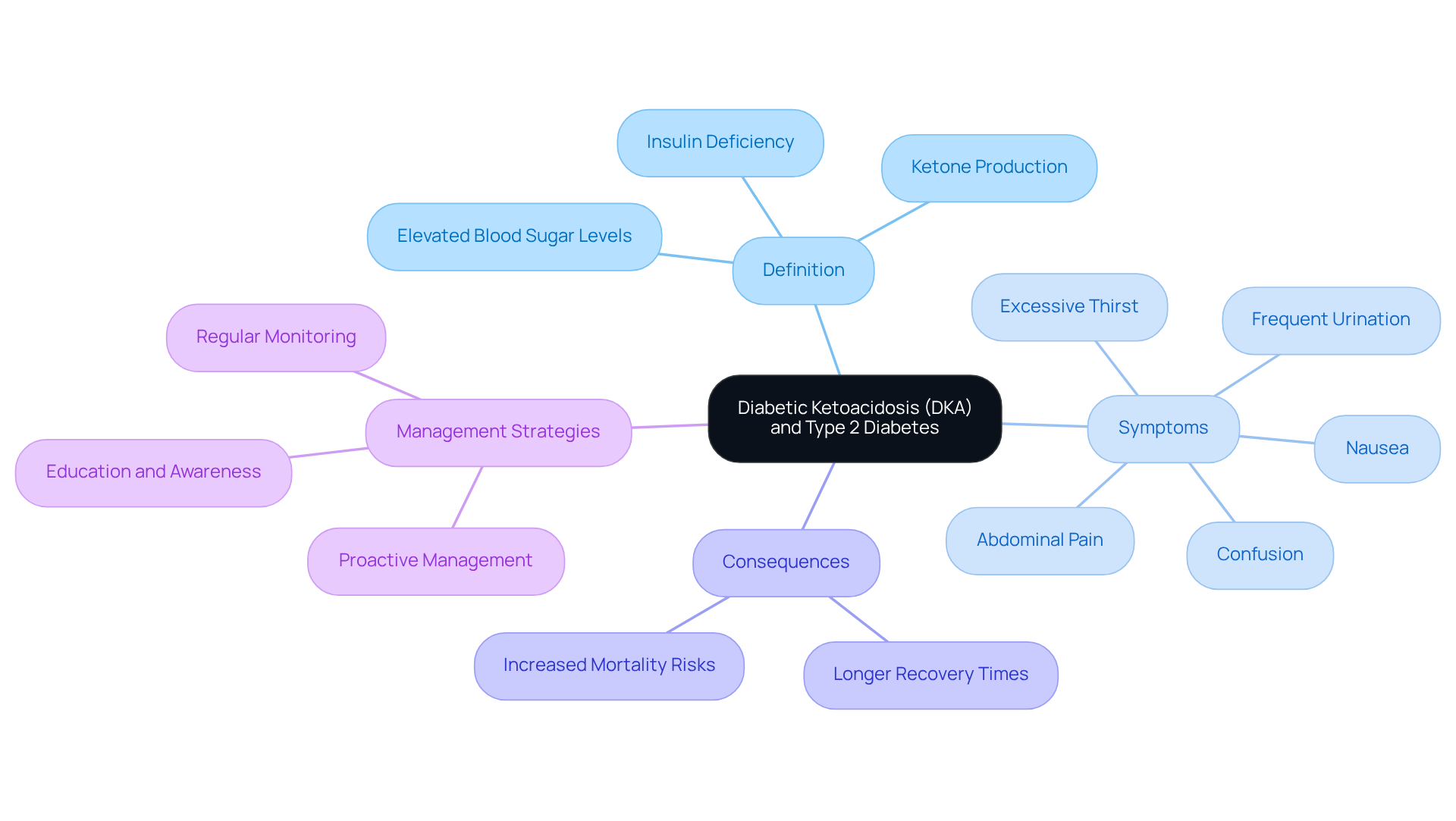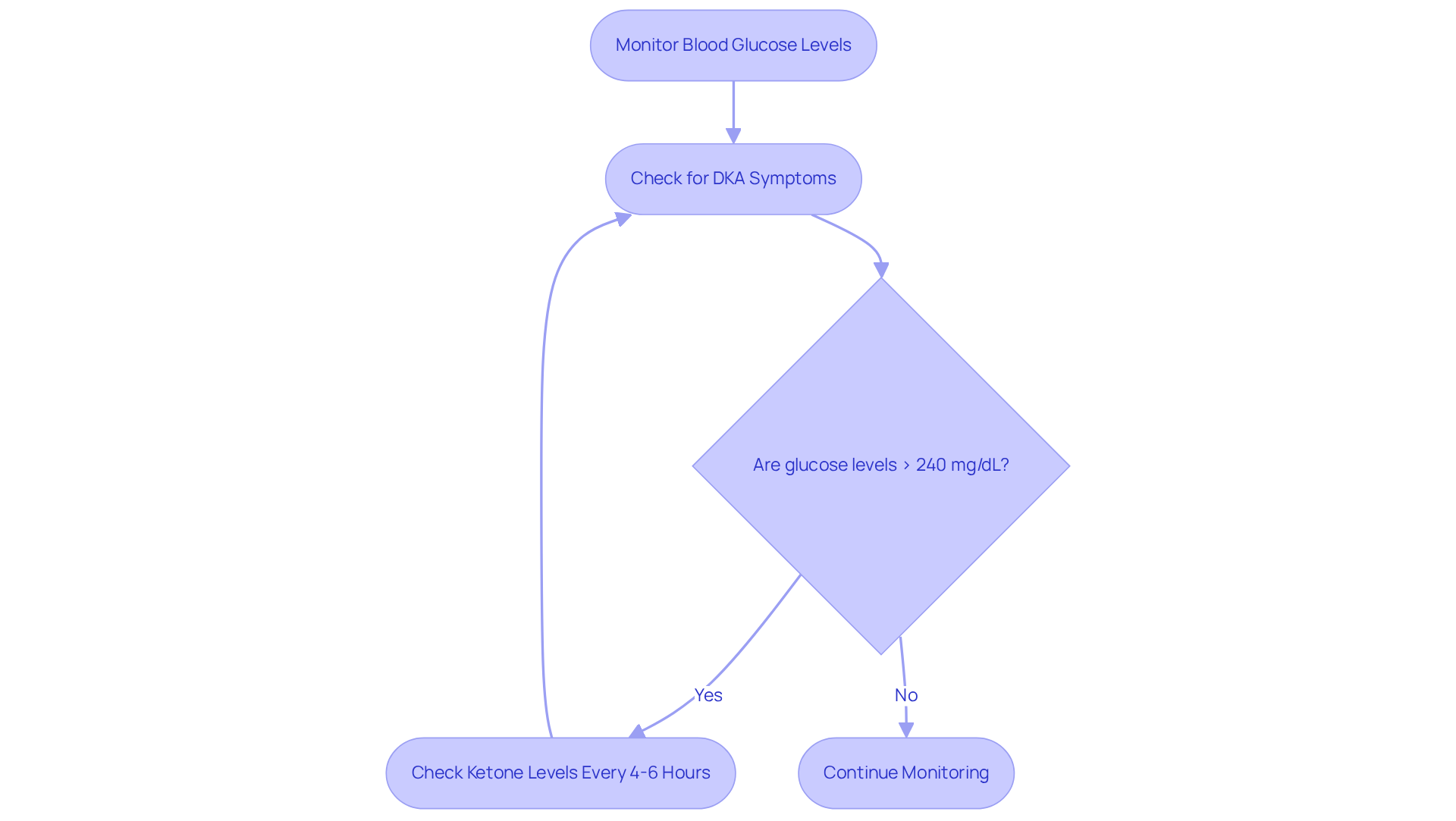Overview
Understanding Diabetic Ketoacidosis (DKA) is crucial for those navigating Type 2 Diabetes. This condition, while often associated with Type 1 Diabetes, poses significant risks for individuals with Type 2 as well. It’s important to recognize the symptoms of DKA and the potential complications that can arise.
Early screening and proactive monitoring are vital. By staying informed and educated, you can help prevent severe complications associated with DKA. Remember, you’re not alone in this journey; many face similar challenges, and support is available.
We encourage you to reach out for resources and connect with others who understand what you’re going through. Together, we can foster a community of support and empowerment.
Introduction
Understanding the complexities of Diabetic Ketoacidosis (DKA) is crucial for managing Type 2 Diabetes, a condition that often feels overshadowed by its more common association with Type 1 Diabetes. As the incidence of Type 2 Diabetes continues to rise—especially among children—it's vital to recognize the symptoms and consequences of DKA for effective health management.
It's understandable to feel overwhelmed by this information. What strategies can individuals and communities implement to recognize and prevent this dangerous complication? How can early screening make a significant difference in outcomes?
We are here to support you every step of the way as you navigate these important questions. Awareness and understanding can empower you and your loved ones to take proactive steps in managing health effectively.
Define Diabetic Ketoacidosis and Its Connection to Type 2 Diabetes
Although Diabetic Ketoacidosis (DKA for type 2 diabetes) is more commonly associated with Type 1 Diabetes, it is also a serious complication that can affect individuals with Type 2 Diabetes. This condition occurs when the body does not have enough insulin, leading to elevated blood sugar levels and the production of acids. When insulin is lacking, the body turns to fat for energy, which can cause a dangerous accumulation of ketones in the bloodstream, potentially resulting in metabolic acidosis.
It’s important to be aware of the key symptoms of DKA, which include:
- Excessive thirst
- Frequent urination
- Nausea
- Abdominal pain
- Confusion
Recognizing these symptoms early is crucial, as prompt treatment can prevent severe complications. Recent studies show that a significant percentage of DKA for type 2 diabetes cases involve individuals with Type 2 Diabetes, highlighting the need for awareness and education in managing this risk.
Real-life experiences highlight the serious consequences of DKA. For example, those hospitalized with DKA often endure longer recovery times and face increased mortality risks, especially if they have pre-existing health conditions. Experts in metabolic disorders stress that proactive management and regular monitoring can greatly reduce the chances of experiencing DKA episodes. By understanding the connection between Type 2 Diabetes and DKA for type 2 diabetes, patients can take informed steps to effectively manage their condition and improve their overall health outcomes.
You're not alone in this journey. We are here to support you every step of the way.

Explore the Rising Incidence of Type 2 Diabetes in Children
The rise of insulin resistance in children is alarming, closely linked to the increasing rates of childhood obesity and sedentary lifestyles. Recent data reveals a worrying surge in type 2 diabetes among youth, with projections suggesting a potential sixfold increase by 2050 if these trends continue. Factors contributing to this issue include:
- Poor dietary choices
- Lack of physical activity
- Genetic predispositions
The early onset of type 2 diabetes poses significant health risks, including the possibility of severe complications such as DKA for type 2 diabetes. It's understandable to feel concerned about these developments, and it's crucial for parents, educators, and healthcare providers to be vigilant for signs of diabetes in children. Together, we can actively promote healthy lifestyle choices.
T2DSolutions aims to be a valuable resource in this effort, offering educational materials and community support to combat childhood obesity and type 2 diabetes rates. Successful community programs focusing on:
- Nutrition education
- Physical activity
- Family engagement
have shown promise in making a difference. Pediatricians stress the urgent need for collective action to tackle this growing epidemic, highlighting that proactive measures, supported by resources like T2DSolutions, can significantly change the course of diabetes in young populations. Remember, you're not alone in this journey; we are here to support you every step of the way.

Highlight the Importance of Screening for Early Detection of DKA
Early detection of Diabetic Ketoacidosis (DKA) is vital for effective diabetes management and the prevention of severe complications. If you have Type 2 Diabetes, it's essential to consistently monitor your blood glucose levels and stay alert for any symptoms of DKA for type 2 diabetes. During times of illness or when your blood glucose levels exceed 240 mg/dL, routine monitoring of ketone levels becomes especially crucial. Symptoms such as nausea, vomiting, and abdominal pain should prompt you to test for specific metabolites right away.
Healthcare providers recommend checking your ketone levels every 4-6 hours if you're feeling unwell or if your blood sugar surpasses this threshold. High ketone levels can significantly increase the risk of DKA for type 2 diabetes, making it important to take these steps. It's understandable to feel concerned about the implications of late detection; statistics indicate that it can lead to serious complications. This underscores the necessity for proactive monitoring.
Real-world examples show that timely screening and education about DKA for type 2 diabetes signs empower individuals just like you to manage DKA for type 2 diabetes effectively. By prioritizing routine screening and raising awareness, you can take crucial steps toward safeguarding your health. Remember, you’re not alone in this journey. We are here to support you every step of the way.

Conclusion
Understanding Diabetic Ketoacidosis (DKA) in the context of Type 2 Diabetes is crucial for effective management and prevention of severe complications. It’s important to recognize that while DKA is often associated with Type 1 Diabetes, it poses a significant risk for individuals with Type 2 Diabetes as well. By understanding the symptoms and the underlying mechanisms, patients can take proactive steps to safeguard their health.
Key insights highlight the alarming rise of Type 2 Diabetes, particularly among children, driven by factors such as obesity and sedentary lifestyles. The importance of early detection and routine monitoring cannot be overstated—timely intervention can prevent the progression to DKA. Healthcare providers emphasize the need for vigilance in screening and educating patients about the signs of DKA. This knowledge empowers individuals to manage their condition effectively.
Ultimately, addressing the rising incidence of Type 2 Diabetes and its complications requires a collective effort. By prioritizing education, promoting healthy lifestyle choices, and ensuring regular monitoring, communities can significantly impact the trajectory of diabetes management. The journey may be challenging, but support is available every step of the way. Remember, awareness and action are key to preventing DKA and improving health outcomes for those living with Type 2 Diabetes. You're not alone in this journey; we are here to support you every step of the way.
Frequently Asked Questions
What is Diabetic Ketoacidosis (DKA) and how is it related to Type 2 Diabetes?
Diabetic Ketoacidosis (DKA) is a serious complication that can occur in individuals with Type 2 Diabetes, although it is more commonly associated with Type 1 Diabetes. DKA happens when the body lacks sufficient insulin, leading to high blood sugar levels and the production of acids called ketones, which can result in metabolic acidosis.
What are the key symptoms of DKA?
The key symptoms of DKA include excessive thirst, frequent urination, nausea, abdominal pain, and confusion. Recognizing these symptoms early is crucial for prompt treatment to prevent severe complications.
Why is awareness of DKA important for those with Type 2 Diabetes?
Awareness of DKA is important because a significant percentage of DKA cases involve individuals with Type 2 Diabetes. Understanding the symptoms and risks can help in managing the condition effectively and reducing the likelihood of DKA episodes.
What are the consequences of DKA for individuals with Type 2 Diabetes?
Individuals hospitalized with DKA often experience longer recovery times and face increased mortality risks, particularly if they have pre-existing health conditions.
How can individuals with Type 2 Diabetes reduce the risk of DKA?
Proactive management and regular monitoring of blood sugar levels can greatly reduce the chances of experiencing DKA episodes. Being informed about the connection between Type 2 Diabetes and DKA allows patients to take steps to manage their condition effectively.



